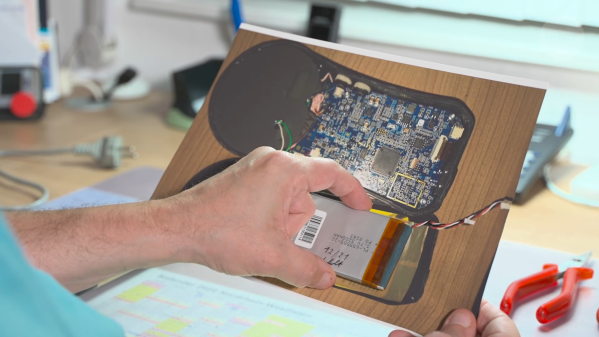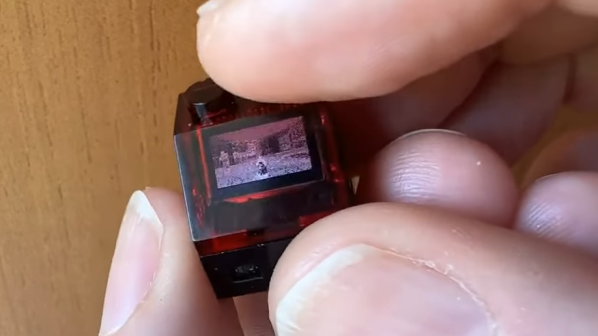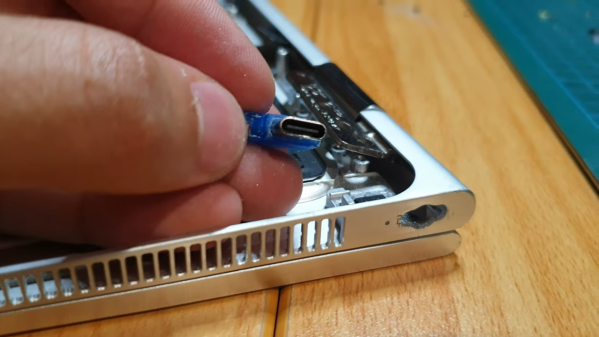We’ve been going on at length in this space about the death spiral that AM radio seems to be in, particularly in the automotive setting. Car makers have begun the process of phasing AM out of their infotainment systems, ostensibly due to its essential incompatibility with the electronics in newer vehicles, especially EVs. That argument always seemed a little specious to us, since the US has an entire bureaucracy dedicated to making sure everyone works and plays well with each other on the electromagnetic spectrum. The effort to drop AM resulted in pushback from US lawmakers, who threatened legislation to ensure every vehicle has the ability to receive AM broadcasts, on the grounds of its utility in a crisis and that we’ve spent billions ensuring that 80% of the population is within range of an AM station.
brick17 Articles
Hacking Headaches: Keeping A Neurostimulator Working
We’ve heard a ton of stories over the years about abandoned technology — useful widgets, often cloud-based, that attracted an early and enthusiastic following, only to have the company behind the tech go bankrupt or decide to end operations for business reasons, which effectively bricks hundreds or perhaps millions of otherwise still-usable devices. Now imagine that happening to your brain.
[Markus Möllmann-Bohle] doesn’t have to imagine it, because he’s living it. [Markus] suffers from chronic cluster headaches, an often debilitating condition that leaves a person with intractable pain. Having lived with these headaches since 1987, and treating them with medications with varying degrees of success, [Markus] was finally delivered from his personal hell by a sphenopalatine ganglion (SPG) neuromodulator. The device consists of an unpowered stimulator implanted under the cheekbone that’s wired into the SPG, a bundle of nerves that supply the sinuses, nasal mucosa, tear glands, and many other structures in the face.
To reverse a cluster headache, [Markus] applies an external transmitter to the side of his face, which powers the implant and directs it to stimulate the SPG with low-frequency impulses, which interferes with a reflex loop that causes the symptoms associated with a cluster headache. [Markus] has been using the implant for years, but now its manufacturer has rolled up operations, leaving him with a transmitter in need of maintenance and the possibility of facing his debilitating headaches once again.
The video below shows [Markus]’s workaround, which essentially amounts to opening up the device and swapping in a new LiPo battery pack. [Markus], an electrical engineer by training, admits it’s not exactly a major hack, but it’s keeping him going for now. But he’s clearly worried because eventually, something will happen to that transmitter that’s beyond his skills to repair.
There’s cause for hope, though, as the intellectual property of the original implant company has been purchased by an outfit called Realeve, with the intention to continue support. That would be a lifesaver for [Markus] and everyone relying on this technology to live a normal life, so here’s hoping there’s no need for future hacking heroics. But as the video below details, there is a lot of neurotechnology out there, and the potential for having that bricked by a corporate decision has to be terrifying to the people who depend on them. Continue reading “Hacking Headaches: Keeping A Neurostimulator Working”
DOOM Ported To A Single LEGO Brick
By now you’ve all seen the tiny LEGO brick with a working screen in it. The work of one [James “Ancient” Brown], it was truly a masterpiece of miniaturization and creativity. Since then, [James] hasn’t stopped innovating. Now, he’s demoing a playable version of DOOM running on a single plastic brick.
We’ve covered the construction of these astounding screen bricks before. Long story short, [James] designed a tiny PCB that hosts an RP2040 microcontroller which is then hooked up to a tiny OLED screen. The components are placed in a silicone mold, which is then filled with transparent resin to form the brick. The screen is then powered via contacts in the bottom, much like older-style LEGO motors.
Early experiments involved running various graphics to emulate a spaceship dashboard, but [James] has now gone much further. He’s implemented RP2040-doom to run the game. It uses tilt controls thanks to an accelerometer, combined with capacitive touch controls for shooting. The monochrome OLED is driven very fast with a special library of [James’] own creation to create three levels of grayscale to make the game actually visible and (just barely) playable.
It’s a hack, of course, and the controls are far from perfect. Nobody’s speed-running E1M1 on [James’s] LEGO brick, to be sure. Perchance. With that said, it’s still a glorious piece of work nonetheless. Just imagine, sitting with friends, and announcing you’re going to play some DOOM — only to pluck a piece of LEGO out of your pocket and start blasting away at demons.
Just because [James] doesn’t know when to quit, we’re going to lay down the gauntlet. Let’s get network play happening on these things, yeah?
Continue reading “DOOM Ported To A Single LEGO Brick”
Hackaday Links: March 5, 2023
Well, we guess it had to happen eventually — Ford is putting plans in place to make its vehicles capable of self-repossession. At least it seems so from a patent application that was published last week, which reads like something written by someone who fancies themselves an evil genius but is just really, really annoying. Like most patent applications, it covers a lot of ground; aside from the obvious capability of a self-driving car to drive itself back to the dealership, Ford lists a number of steps that its proposed system could take before or instead of driving the car away from someone who’s behind on payments.
Examples include selective disabling conveniences in the vehicle, like the HVAC or infotainment systems, or even locking the doors and effectively bricking the vehicle. Ford graciously makes allowance for using the repossessed vehicle in an emergency, and makes mention of using cameras in the vehicle and a “neural network” to verify that the locked-out user is indeed having, say, a medical emergency. What could possibly go wrong?
More Detail On That Fantastic Lego OLED Brick
It’s always great when we get a chance to follow up on a previous project with more information, or further developments. So we’re happy that [“Ancient” James Brown] just dropped a new video showing the assembly of his Lego brick with a tiny OLED screen inside it. The readers are too, apparently — we got at least half a dozen tips on this one.
We’ve got to admit that this one’s a real treat, with a host of interesting skills on display. Our previous coverage on these bedazzled bricks was disappointingly thin on details, and now the original tweets even seem to have disappeared entirely. In case you didn’t catch the original post, [James] found a way to embed a microcontroller and a remarkably small OLED screen into a Lego-compatible brick — technically a “slope 45 2×2, #3039” — that does a great job of standing in for a tiny computer monitor.
Continue reading “More Detail On That Fantastic Lego OLED Brick”
Laptop USB-C Charging Hack Lets You Leave The Brick At Home
At their best, laptops are a compromise design. Manufacturers go to great lengths to make the slimmest, lightest, whatever-est laptops possible, and the engineering that goes into doing so is truly amazing. But then they throw in the charger, which ends up being a huge brick with wire attached to it, and call it a day.
Does it have to be that way? Probably, but that doesn’t mean we can’t try to slim down the overall footprint of laptops at least a little. That’s what [Joe Gaz] did when he hacked his laptop to allow for USB-C charging. Tired of the charger anchoring down his HP X360, [Joe] realized that he could harvest the PCB from a USB-C charger adapter dongle and embed it inside his laptop. We’ve seen similar modifications made to Thinkpads in the past, and it’s good to see the process isn’t that far removed with other brands.
 After popping open the laptop, which is always an adventure in reverse mechanical engineering, he found that removing the OEM charger jack left just enough room for the USB-C charger. Mounting the board required a 3D printed bracket, while enlarging the original hole in the side of the laptop case took some cringe-inducing work with a file. It looked like it was going to be pretty sloppy at first, but he ended up doing a pretty neat job in the end. The whole modification process is in the video below.
After popping open the laptop, which is always an adventure in reverse mechanical engineering, he found that removing the OEM charger jack left just enough room for the USB-C charger. Mounting the board required a 3D printed bracket, while enlarging the original hole in the side of the laptop case took some cringe-inducing work with a file. It looked like it was going to be pretty sloppy at first, but he ended up doing a pretty neat job in the end. The whole modification process is in the video below.
The end result is pretty slick — [Joe] can now carry a much more compact USB wall-wart-style charger, or eschew the charger altogether and rely on public USB charging stations. Either way, it sure beats lugging a brick around. If you’re interested in laptop hacking, or even if you just want to harvest the goodies from a defunct machine, check out this guide to laptop anatomy by our own [Arsenijs Picugins].
Continue reading “Laptop USB-C Charging Hack Lets You Leave The Brick At Home”
Hackaday Links: September 26, 2021
Dealing with breakdowns is certainly nothing new for drivers; plenty of us have had our ride die in mid-flight, and experienced the tense moment when it happens in traffic. But the highly integrated and instrumented nature of the newest generation of electric vehicles can bring an interesting twist to the roadside breakdown, if the after-action report of a Tesla driver is any indication.
While driving on a busy road at night, driver [Pooch] reports that his Tesla Model S started beeping and flashing warnings to get to the side of the road right away. [Pooch] tried to do so, but the car died, coasted to a stop in the middle of the road, and engaged the parking brakes. The bricked Tesla would have been a sitting duck in the middle of the road but for a DOT crew who happened to be nearby and offered to provide some protection while [Pooch] waited for help. The disturbing part was the inability to get the car into any of the service modes that might let it be pushed off to the shoulder rather than stuck in traffic, something that’s trivial to do in ICE vehicles, at least older ones.
In other electric vehicle news, Chevy Bolt owners are turning into the pariahs of the parking garage. General Motors is telling Bolt EV and EUV owners that due to the risk of a battery fire, they should park at least 50 feet (15 meters) away from other vehicles, and on the top level of any parking structures. There have been reports of twelve battery fires in Bolts in the US recently, which GM says may be due to a pair of manufacturing defects in the battery packs that sometimes occur together. GM is organizing a recall to replace the modules, but isn’t yet confident that the battery supplier won’t just be replicating the manufacturing problem. The social distancing rules that GM issued go along with some fairly stringent guidelines for charging the vehicle, including not charging overnight while parked indoors. With winter coming on in the northern hemisphere, that’s going to cause a bit of inconvenience and probably more than a few cases of non-compliance that could end in tragedy.
Fans of electronic music might want to check out “Sisters with Transistors”, a documentary film about some of the pioneering women of electronic music. Electronic music has been around a lot longer than most of us realize, and the film reaches back to the 1920s with Theremin virtuoso Clara Rockmore, and continues on into the 1980s with Laurie Spiegel, whose synthesizer work has been speeding away from Earth for the last 44 years on the Golden Records aboard the Voyager spacecraft. Hackaday readers will no doubt recognize some of the other women featured, like Daphne Oram and Delia Derbyshire, who cobbled together the early Dr. Who music with signal generators, tape loops, and random bits of electronics in the pre-synthesizer days of the early 60s. We’ve watched the trailer for the film and it looks pretty good — just the kind of documentary we like.
We’re big fans of circuit sculpture around here, and desperately wish we had the patience and the skill to make something like Mohit Bhoite or Jiri Praus can make. Luckily, there’s now a bit of a shortcut — Geeek Club’s Cyber Punk PCB Construction Kit. These kits are a little like the love child of Lego and PCBWay, with pieces etched and cut from PCB stock. You punch the pieces out, clean up the mouse bites, put Tab A into Slot B, and solder to make the connection permanent. Each kit has some components for the requisite blinkenlight features, which add to the cool designs. Looks like a fun way to get someone started on soldering, or to build your own skills.
And finally, another nail was driven into the coffin of Daylight Savings Time this week, as the island nation of Samoa announced they wouldn’t be “springing ahead” as scheduled this weekend. Daylight Savings Time has become a bone of contention around the world lately, and mounting research shows that the twice-yearly clock changes cause more trouble than they may be worth. In Europe, it’s due to be banned as soon as all the member nations can agree on normal time or summer time.
In the case of Samoa, DST was put into effect in 2010 on the assumption that it would give plantation workers more productive hours in the field and save energy. Instead, the government found that the time change just gave people an excuse to socialize more, which apparently upset them enough to change the rule. So there you have it — if you don’t like Daylight Savings Time, start partying it up.
















